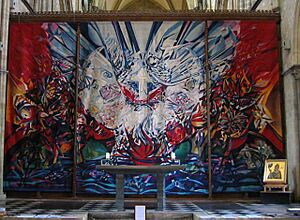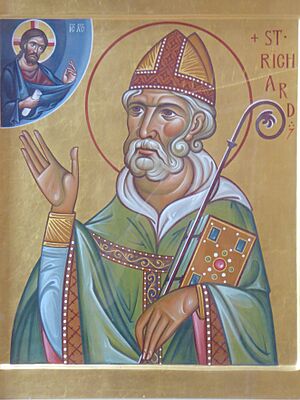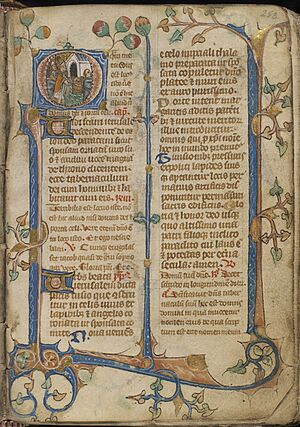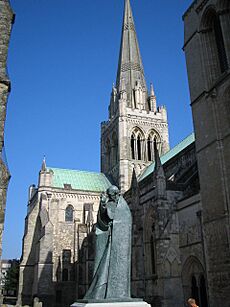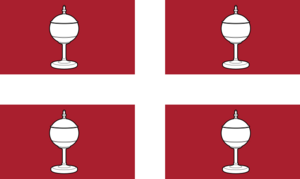Richard of Chichester facts for kids
Quick facts for kids Saint Richard of Chichester |
|
|---|---|
| Bishop of Chichester | |
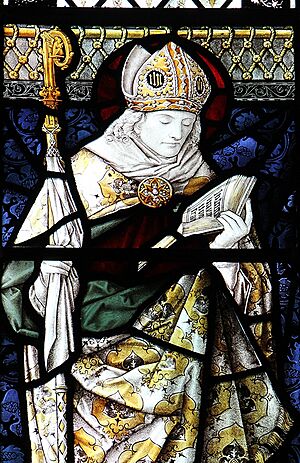
Stained glass image of St. Robert of Chichester at Church of St Saviour and St Peter, Eastbourne
|
|
| Enthroned | 1244 |
| Reign ended | 1253 |
| Predecessor | Robert Passelewe |
| Successor | John Climping |
| Other posts | Vicar of Deal |
| Personal details | |
| Birth name | Richard |
| Born | c. 1197 Droitwich, Worcestershire, England |
| Died | 3 April 1253 Dover, Kent, England |
| Denomination | Catholic |
| Sainthood | |
| Feast day | 3 April (Roman Catholic Church and some provinces of the Anglican Communion), 16 June (in some provinces of the Anglican Communion) |
| Venerated in | Roman Catholic Church Anglican Communion |
| Title as Saint | Bishop and Confessor |
| Canonized | 25 January 1262 Viterbo, Lazio, Papal States by Pope Urban IV |
| Attributes | Bishop with a chalice on its side at his feet because he once dropped the chalice during a Mass and nothing spilled from it; kneeling with the chalice before him; ploughing his brother's fields; a bishop blessing his flock with a chalice nearby |
| Patronage | Coachmen; Diocese of Chichester; Sussex, England |
| Shrines | Chichester Cathedral |
Richard of Chichester (born around 1197 – died April 3, 1253), also known as Richard de Wych, was an important religious leader. He became a saint in 1262 and served as the Bishop of Chichester.
In Chichester Cathedral, a special shrine was built for Richard. It was beautifully decorated and became a popular place for pilgrimage, where people traveled to show their faith. However, in 1538, during the reign of King Henry VIII of England, the shrine was destroyed by order of Thomas Cromwell.
Richard of Chichester is the patron saint of Sussex in southern England. Since 2007, his special day, June 16, has been celebrated as Sussex Day.
Contents
The Life of Saint Richard
Saint Richard was born near a town called Wyche, which is now Droitwich in Worcestershire. He grew up in a gentry family, which means his family had a good social standing. Sadly, he became an orphan when his parents died.
Richard's Early Life and Choices
When Richard's parents passed away, his older brother was supposed to inherit the family lands. But his brother was too young. This meant the lands were managed by someone else until he was old enough. When his brother finally took over, he had to pay a large tax, which made the family quite poor. Richard even had to work on the farm to help out.
His brother also named Richard as the next heir to the estate. Friends tried to arrange a marriage for Richard with a "noble lady." But Richard chose a different path. He suggested his brother marry her instead and gave the family lands back to him. Richard preferred a life of study and serving the Church.
Education and Church Service
Richard studied at the famous University of Oxford. He soon started teaching there himself. After Oxford, he continued his studies in Paris and then Bologna. In Bologna, he became very skilled in canon law, which is the law of the Church.
In 1235, Richard returned to England and was chosen as the chancellor of Oxford University. His former teacher, Edmund of Abingdon, had become the archbishop of Canterbury. Richard believed in the same ideas as Edmund, wanting to improve the clergy and support the Pope's rights, even against the king.
In 1237, Archbishop Edmund made Richard the chancellor for the diocese of Canterbury. Richard joined the archbishop when he was exiled to Pontigny. He was with him when the archbishop died around 1240. After this, Richard decided to become a priest. He studied theology for two years with the Dominicans, a religious order, in Orléans.
When he came back to England, Richard became a parish priest in Charing and Deal. Soon after, the new archbishop, Boniface of Savoy, again appointed him chancellor of Canterbury.
Becoming Bishop of Chichester
In 1244, Saint Richard was chosen to be the Bishop of Chichester. However, King Henry III of England and some church leaders did not agree with this choice. The king wanted someone else, Robert Passelewe, to be bishop.
Archbishop Boniface refused to approve Passelewe. So, both sides asked the Pope for a decision. The king then took away all the church's properties and money in Chichester. But Innocent IV, the Pope, confirmed Richard's election and made him bishop in Lyons in March 1245.
Richard returned to Chichester, but the king refused to give back the church's properties for two years. He only did so after being threatened with excommunication, which means being officially excluded from the Church. King Henry III even forbade anyone from giving Richard a place to stay or food.
At first, Richard lived with his friend Simon, a parish priest, in Tarring. He traveled all over his diocese on foot, visiting everyone. In his free time, he even grew figs!
Richard's Simple Life and Rules
Richard was known for living a very simple and strict life. He was an ascetic, meaning he avoided luxuries. He wore a rough hair-shirt and refused to eat from silver dishes. His diet was simple, and he strictly avoided meat, having been a vegetarian since his time at Oxford.
Richard helped a writer named Matthew Paris gather information for the life story of St. Edmund Rich. He also started a tradition of offerings for Chichester Cathedral, which later became known as "St. Richard's pence."
Richard was very strict with people who charged too much interest on loans (called usurers). He also disliked corrupt clergy and priests who mumbled during Mass. He was very firm about protecting the rights of the clergy.
Richard's time as bishop was marked by his support for the Dominican Order. This was because a Dominican house in Orléans had helped him when he was in France. He was also very serious about encouraging a crusade, a religious war.
Richard died at the age of 56 on April 3, 1253, in Dover. He had been ordered by the Pope to preach a crusade there. His body was taken to Chichester and buried in a chapel dedicated to his patron, St. Edmund. His remains were later moved to a new shrine in 1276.
Church Rules and Reforms
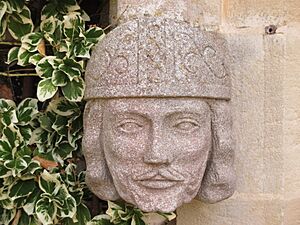
After the church's properties and money were returned to him in 1246, Bishop Richard was very eager to improve the behavior and morals of his clergy. He also wanted to bring more order and respect to church services.
Richard was strong in protecting the clergy from harm. He gave severe punishments to knights who attacked priests.
With the help of his church leaders, Richard created a set of rules, called statutes. These rules were for organizing the church in his diocese and for guiding how the clergy should behave. It seems that many clergy were still secretly married, even though church law did not allow it. Richard worked hard to stop this practice in his diocese.
Richard's statutes included rules like these:
- Clergy who were married would lose their church jobs and income (called benefices).
- Their partners (called concubines, as the church did not recognize their marriage) would lose church privileges, even after death. They could not inherit property from their partners; any such gifts would go to the cathedral.
- New priests had to promise to remain unmarried.
- Rectors (head priests) were expected to live in their parishes, be welcoming, and help those in need.
- People had to pay their tithes (a portion of their annual crops or income for the church). If they didn't, they wouldn't receive forgiveness for their sins until they paid.
- Vicars (priests who served in a parish) had to be priests and only have one church job. They were not allowed to hold another parish under a different name.
- Deacons (assistants to priests) were not allowed to hear confessions or give punishments for sins. They also couldn't baptize people unless a priest was not available.
- Children had to be confirmed within a year of being baptized.
- People had to learn the Apostles' Creed and the Lord's Prayer in their own language.
- Priests had to celebrate Mass in clean robes, use a silver or gold chalice (cup), and have clean altar cloths.
- The cross had to be placed in front of the priest during Mass.
- The bread for communion had to be made from the purest wheat flour, and the wine mixed with water.
- The communion elements could not be kept for more than seven days. When carried to a sick person, they had to be in a special container (a pyx), and the priest had to be led by a cross, a candle, holy water, and a bell.
- Activities like gambling at baptisms and weddings were strictly forbidden.
- Archdeacons (senior clergy) were to handle justice fairly, without asking for extra money to speed up or delay things. They had to visit churches regularly to make sure services were done correctly, and that church items and clothes were in good order. They also had to ensure the Mass was said correctly and clearly. Priests who rushed or mumbled words were to be suspended.
- Clergy should wear their proper church clothes and not dress like ordinary people. They were not allowed to have long hair or romantic relationships.
- The names of people who had been excommunicated were to be read out four times a year in parish churches.
- Every priest in the diocese had to keep a copy of these rules and bring it to church meetings.
Saint Richard's Shrine
Many people believed that miracles happened at Richard's tomb in Chichester Cathedral. It became a very popular place for people to visit on pilgrimage. In 1262, just nine years after his death, he was made a saint by Pope Urban IV in Viterbo.
Richard's feast day (a special day to remember him) is April 3 in the Western Church. However, because this date often falls during Lent or Easter, it is usually celebrated on June 16 in some parts of the Anglican Church. The Anglican Church remembers St. Richard more widely than the Roman Catholic Church. In the Church of England, he is remembered with a special day on June 16.
The first Anglican bishop of Chichester was Richard Sampson, during the time of King Henry VIII of England. The king, through his chief minister Thomas Cromwell, ordered the destruction of Richard's shrine in Chichester Cathedral in 1538.
Up to this point, St. Richard's Shrine was almost as popular as the shrine of Thomas Becket in Canterbury. The order to destroy the shrine was given to two men, Sir William Goring and William Ernley. They were paid £40 for carrying out the task on December 20, 1538.
One of the royal officials involved in destroying the shrine, William Ernley, was connected to the parish of West Wittering in Sussex. It is believed that someone from there might have secretly taken the relics (bones or other remains) of St. Richard and hidden them in their local church. Local stories say that parts of the saint's remains can still be found there.
The Lady Chapel in West Wittering Church has an old broken marble slab. It is carved with a bishop's staff and a Greek cross. People believe it came from a container that held the relics of St. Richard of Chichester. He was a 13th-century bishop who often visited West Wittering. Part of his story is shown in a beautiful altar cloth. On the left, St. Richard is shown feeding the hungry. On the right, he is leading his followers from the church, with his candle miraculously staying lit even though a gust of wind blew out all the other candles.
The modern St. Richard's Shrine is located in Chichester Cathedral. It was re-established in 1930. In 1987, during the restoration of an abbey in Normandy, France, the lower part of a man's arm was found in a container. People thought it might be Richard's relic. After being checked, it was given to Bishop Eric Kemp and brought to the cathedral on June 15, 1990. The relic was buried in 1991 under the St. Richard altar. Another relic, with a certificate of authenticity, was also given from Rome and is now in the bishop's chapel in Chichester. The modern shrine of Richard has an altar designed by Robert Potter, a tapestry, and an icon (a religious painting) by Sergei Fyodorov. The icon shows St. Richard blessing people, and also praying to Christ.
A Famous Prayer
Richard is widely remembered today for a popular prayer that is said to be his:
Thanks be to Thee, my Lord Jesus Christ For all the benefits Thou hast given me, For all the pains and insults Thou hast borne for me. O most merciful Redeemer, friend and brother, May I know Thee more clearly, Love Thee more dearly, Follow Thee more nearly.
Richard is believed to have said this prayer on his deathbed, surrounded by the clergy. The words were written down in Latin by his confessor, Ralph Bocking, a Dominican friar. They were later published in a large book called the Acta Sanctorum, which contains documents about the lives of Christian saints. A copy in the British Library is thought to contain Bocking's original writing of the prayer.
The person who translated the Latin into English was very skilled. They managed to create a rhyming part: "clearly, dearly, nearly." However, older versions of St. Richard's prayer from before the 20th century did not have this rhyme. It is thought that the first version with the rhyme was published in "The Churchmans Prayer Manual" in 1913.
The prayer was later adapted for the song "Day by Day" in the musical Godspell (1971). The words used in the song were based on a version from "Songs of Praise, Enlarged Edition."
A part of the prayer has been included in the Roman Catholic Church's worship. It is used by special groups that bring Anglican traditions into the Catholic Church. Saint Richard of Chichester is remembered on June 16 in their calendar, and a special prayer is said:
MOST merciful Redeemer, who gavest to thy Bishop Richard a love of learning, a zeal for souls, and a devotion to the poor: grant that, encouraged by his example, and aided by his prayers, we may know thee more clearly, love thee more dearly, and follow thee more nearly, day by day; who livest and reignest with the Father in the unity of the Holy Spirit, ever one God, world without end. Amen.
Patron Saint and Festivals
Richard is the patron saint of the county of Sussex in England. Since 2007, his special day, June 16, has been celebrated as Sussex Day.
Richard is also honored with a feast day on the church calendar of the Episcopal Church (USA) on April 3. This is also the date for his remembrance in the Roman Catholic Church's calendar since 2004.
See also
- List of Catholic saints
- History of Christianity in Sussex
- History of Sussex
- West Sussex


